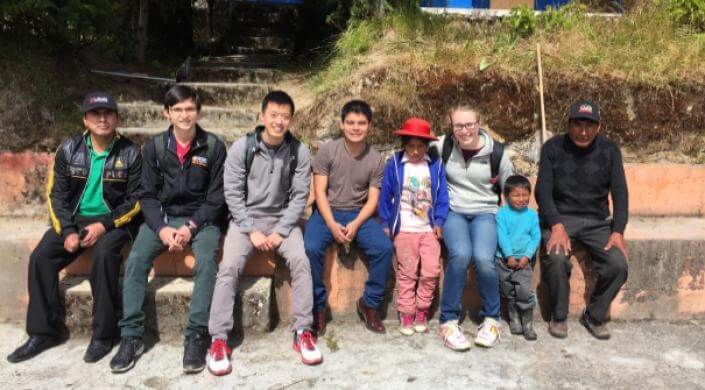News
The students meet with several schoolchildren in the Peruvian highlands. Harvard students: Antuan Tran (second from left), Alex Yang (third from left) and Haley Baker (third from right).
For young children growing up in the United States, Play-Doh is as much a part of daily life as “Sesame Street” and macaroni and cheese. But a team of students from the Harvard John A. Paulson School of Engineering and Applied Sciences are using the popular toy to introduce STEM (science, technology, engineering, and math) concepts to children living high in the Andes Mountains.
Their educational product, called Klay, is a bit more complicated than the simple Play-Doh molds you may remember from your childhood. Utilizing the conductivity of Play-Doh, the hands-on toy challenges users to play different games by arranging patterns onto the surface of a specially programmed circuit board.
The concept for the project was born last spring, when biomedical engineering concentrator Alex Yang, S.B. ’17, learned about the Deutsche Bank Challenge, an annual award program that funds projects that address major socioeconomic and environmental issues in Peru. Yang, who had experience developing educational toolkits for children in Africa, reached out to friend Haley Baker, A.B. ’17. A dual concentrator in social anthropology and history and literature, Baker had recently worked with kindergarten teachers during an externship in Chile. The two brought in Antuan Tran, A.B. ’17, a computer science concentrator, drawing on his expertise programming custom circuit boards.
The Harvard team members joined Oscar Pacheco and Sandra Ruiz, students at the University of Engineering and Technology (UTEC) in Lima to develop the game system. Their original design involved microprocessors embedded in Play-Doh that children could use to learn basic physics, like circular motion, Yang explained. Their concept won the challenge and $20,000 in seed funding.
Grant money in hand, Yang, Baker, and Tran flew to Peru to develop their toy. But the project changed course once the students traveled to a remote elementary school high in the Andes. After waiting all morning for schoolchildren to arrive, the Harvard students realized their project had a major flaw.
“One girl finally showed up for school, but she brought her little brother and the family’s flock of sheep. They had walked all morning just to get there,” said Yang. “We realized right then that our idea wasn’t going to work. There’s no way to teach these kids physics when most of them hardly ever come to school and have barely gotten any basic math education.”
The rural Andes have a very limited transportation infrastructure and a steadily declining population, Yang explained. Most families survive through subsistence agriculture, so few children are able to attend school regularly, added Baker. To compound the problem, this school, which was a single room in a community center, often lacked a teacher because of funding shortages.
The Harvard students returned to the engineering design laboratory at UTEC and went back to the drawing board.
They retooled their project so that, instead of focusing on physics, the system was programmed to play hands-on games that teach basic math and emphasize problem solving, logic, and memory skills.
“Our goal was to introduce concepts that will help these young kids solidify knowledge they can use later in the classroom,” said Baker. “We also learned that we needed to create something that could be easily brought to the home, since it is so difficult for these children to get to school.”
They programmed an inexpensive, lightweight circuit board so a child could place Play-Doh in patterns on the board’s sensors to play simple games. For example, one game asks the player to match a pattern displayed on the circuit board’s screen by placing an identical arrangement of Play-Doh onto the sensors. Another game quizzes players by challenging them to add, subtract, multiply, or divide with balls of Play-Doh placed on either side of an arithmetic sign.
Play-Doh is a great teaching tool for disadvantaged children living in rural areas, since the toy is both inexpensive and easy to produce, Yang said. Do-it-yourself conductive Play-Doh can be made from water, flour, salt, lemon juice, and vegetable oil.
The students fast-tracked a prototype and put their creation to the test in the hands of elementary schoolchildren. Peruvian teachers helped the team determine the games that would be most beneficial for young students.
Those classroom visits inspired the final version of the board, which is currently being manufactured. It includes a series of colorful, cardboard covers that are placed over the board’s sensors for each game. Ultimately, the team aims to develop a system that can be sold for less than $15, Yang said.
Now that the board is in production, Yang and his teammates are gearing up for a trip back to Peru, where they’ll be able to distribute their product to families living in the Andes.
In the end, developing the teaching tool proved to be an educational experience for the Harvard students as well, Yang said.
“It was great to be able to apply the knowledge that I’ve gained through my engineering and computer science classes and actually make a product that could really have a positive impact on a lot of people,” Tran said. “We had to think through everything, every step of the way. But having a project that was so self-driven, it really has been very freeing to work on.”
Cutting-edge science delivered direct to your inbox.
Join the Harvard SEAS mailing list.
Press Contact
Adam Zewe | 617-496-5878 | azewe@seas.harvard.edu
